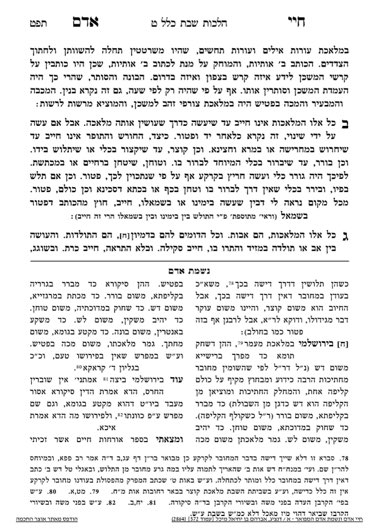We are continuing siman 3. Yesterday, we learned some of the concepts of this siman, and today we will read them inside. The Chayei Adam writes that the list of melachos discussed previously (siman 1) are avos. Other actions which are parallel to them are toldos. Whether a person transgresses an av or a toldah, if it was committed b’meizid, and they were warned by kosher witnesses, they are chayav sekilah. If they were not warned, but it was committed b’meizid, they are chayav kareis. If it is transgressed b’shogeig, they are chayav a korban chatas.
The MIshnah actually differentiates a little further, and says that if a person forgot it was Shabbos, even if they committed multiple melachos, they are only chayav one korban. However, they are chayav a separate korban for each Shabbos on which they forgot it is Shabbos.
If a person knew it was Shabbos, but forgot that certain types of melacha are assur, they bring a korban for each type of melacha they transgressed.
In the Sefer Even Ha’Azel, Rav Isser Zalman Meltzer (father in law of Rav Aharon Kotler) helps us understand what makes a melacha an av and what makes it a toldah. Although he is discussing boneh specifically, through his example we can understand the process. He defines the melacha of boneh as having two components. In the mishkan, the act of boneh was taking the kerashim (beams) and erecting them to create the mishkan. Hence, we notice two things: A, the result of a usable structure for protection, etc., and B. the action of putting pieces together.
The Rambam writes that if a person creates an ohel out of one piece of cloth, it is assur as a toldah, because although it creates a structure, there are no pieces put together, as there were with the mishkan.
Another example is if a person takes a broken or dismantled utensil and puts it back together. Although it is not a structure that one lives in and therefore not like the av, it is still a toldah of boneh, because it puts pieces together to create something.
In other words, we look at the av and identify its primary elements, and we find the action which is performed and the result which it has accomplished. When both of those are present in the melacha, it is the av melacha of boneh. If we find another melacha which is similar to one of the elements (either the act of putting the pieces together or the result of having a structure), but missing the other element, it is considered a toldah.
There are certain scenarios where Chazal create parallel avos. For example, there was no baking in the creation of the mishkan (there was baking once the miskhan was running, but not in its setup). However, they used cooking to prepare the dyes used for the walls. Cooking is defined as when using water, and baking is defined as when not using liquids.
The Mishnah in Maseches Shabbos which delineates the 39 melachos writes ofeh (baking) rather than bishul (cooking) as the av melacha, even though ofeh was not used in the construction of the mishkan. However, the answer is that bishul and ofeh are so similar–using heat to create permanent change in an item–that they are two parallel avos.
Since they are not exactly the same, each one can have different toldos, whereas had they been considered the same, there may have been actions which were too different than the “merged” av, and they would not be considered a toldah. Now that they are separate avos, these toldos will be included
Summary
- An av is the primary source of a Shabbos melachah, and a toldah is its derivatives.
- The practical application of the avos and toldos of Shabbos is that if one trangresses melachos b’shogeig, they bring one korban per av melacha transgressed, and the toldos are subsumed under the av transgressed.
- An av is defined as having all of the primary components of the melacha which was performed in the mishkan. If any of those components are missing, but it is still similar to the av, it will be considered a toldah.



